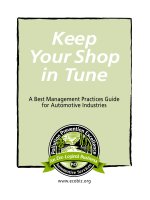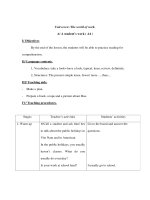basic concepts in biochemistry a student's survival guide 2d ed - hiram f. gilbert
Bạn đang xem bản rút gọn của tài liệu. Xem và tải ngay bản đầy đủ của tài liệu tại đây (6.32 MB, 312 trang )
BASIC CONCEPTS IN
• • • • • • • • • • • •
A STUDENT'S SURVIVAL GUIDE
BIOCHEMISTRY
Second Edition
HIRAM F. GILBERT, Ph.D.
Professor of Biochemistry
Baylor College of Medicine
Houston, Texas
McGraw-Hill
Health Professions Division
New York St. Louis San Francisco
Auckland Bogotá Caracas Lisbon London Madrid
Mexico City Milan Montreal New Delhi San Juan
Singapore Sydney Tokyo Toronto
BASIC CONCEPTS IN BIOCHEMISTRY, 2/E
Copyright © 2000, 1992 by the McGraw-Hill Companies, Inc. All
rights reserved. Printed in the United States of America. Except as per-
mitted under the United States Copyright Act of 1976, no part of this
publication may be reproduced or distributed in any form or by any
means, or stored in a data base or retrieval system, without the prior
written permission of the publisher.
1234567890 DOCDOC 99
ISBN 0-07-135657-6
This book was set in Times Roman by Better Graphics, Inc. The edi-
tors were Steve Zollo and Barbara Holton; the production supervisor
was Richard Ruzycka; the index was prepared by Jerry Ralya. R. R.
Donnelley and Sons was the printer and binder.
This book is printed on acid-free paper.
Cataloging-in-Publication Data is on file for this book at the
Library of Congress.
Basic Concepts in Biochemistry: A Student’s Survival Guide is not a con-
ventional book: It is not a review book or a textbook or a problem book.
It is a book that offers help in two different ways—help in understanding
the concepts of biochemistry and help in organizing your attack on the
subject and minimizing the subject’s attack on you.
This book presents what are often viewed as the more difficult con-
cepts in an introductory biochemistry course and describes them in
enough detail and in simple enough language to make them understand-
able. We surveyed first- and second-year medical students at a national
student meeting asking them to list, in order, the parts of biochemistry
they found most difficult to understand. The winner (or loser), by far, was
integration of metabolism. Metabolic control, pH, and enzyme kinetics
ran closely behind, with notable mention given to molecular biology and
proteins.
Biochemistry texts and biochemistry professors are burdened with
the task of presenting facts, and the enormity of this task can get in the
way of explaining concepts. Since I don’t feel burdened by that necessity,
I’ve only outlined most of the facts and concentrated on concepts. My
rationale is that concepts are considerably easier to remember than facts
and that concepts, if appropriately mastered, can minimize the amount of
material that has to be memorized—you can just figure everything out
when required. In Basic Concepts in Biochemistry, central concepts are
developed in a stepwise fashion. The simplest concepts provide a review
of what might have been forgotten, and the more complex concepts pre-
sent what might not have been realized.
•
P R O L O G U E
•
xv
• • • • • • • • • • • •
Preface xiii
Prologue xv
CHAPTER 1 WHERE TO START 1
Instructions 1
What Do I Need to Know? 2
Instructions for Use 2
Studying and Exams 2
Trivia Sorter 4
CHAPTER 2 PROTEIN STRUCTURE 6
Amino Acid Structure 6
Interactions 8
Water 9
Hydrophobic Interaction 9
van der Waals Interactions and London Dispersion Forces 11
Hydrogen Bonds 11
Secondary Structure 12
Protein Stability 15
Favorable (Good) Interactions 17
Unfavorable (Bad) Interactions 17
Temperature-Sensitive Mutations 19
Ligand-Binding Specificity 20
Global Conclusion 21
CHAPTER 3 MEMBRANES AND
MEMBRANE PROTEINS 22
General Membrane Function 22
Membrane Composition 23
Phospholipid Bilayer 24
Membrane Structure 25
Posttranslational Modification 26
Membrane Fluidity 27
Diffusion in Membranes 28
Movement of Ions and Molecules Across Membranes 28
•
CONTENTS
•
v
Transport Across Membranes 29
The Nernst Equation 31
CHAPTER 4 DNA-RNA STRUCTURE 35
DNA Structure 35
DNA Stability 37
RNA Secondary Structure 38
CHAPTER 5 EXPRESSION OF GENETIC
INFORMATION 40
Information Metabolism 40
Directions and Conventions 41
DNA Replication 42
Types of DNA Polymerase 45
Recombination 47
Regulation of Information Metabolism 49
Transcription 53
Regulation of Transcription 55
Translation 57
Use of High-Energy Phosphate Bonds During Translation 60
CHAPTER 6 RECOMBINANT-DNA METHODOLOGY 61
Restriction Analysis 61
Gels and Electrophoresis 65
Blotting 67
Restriction Fragment-Length Polymorphism 69
Cloning 70
Sequencing 73
Mutagenesis 75
Polymerase Chain Reaction 76
CHAPTER 7 ENZYME MECHANISM 80
Active Site 81
Transition State 81
Catalysis 83
Lock and Key 83
Induced Fit 83
Nonproductive Binding 85
Entropy 87
Strain and Distortion 88
• vi • Contents
Transition-State Stabilization 88
Transition-State Analogs 91
Chemical Catalysis 93
CHAPTER 8 ENZYME KINETICS 95
S, P, and E (Substrate, Product, Enzyme) 96
Amounts and Concentrations 96
Active Site 97
Assay 98
Velocity 98
Initial Velocity 100
Mechanism 101
Little k’s 102
Michaelis-Menten Equation 103
V
max
106
k
cat
106
K
m
107
Special Points 107
k
cat
/K
m
107
Rate Accelerations 108
Steady-State Approximation 109
Transformations and Graphs 111
Inhibition 112
Allosterism and Cooperativity 117
The Monod-Wyman-Changeaux Model 119
CHAPTER 9 SIGNAL TRANSDUCTION PATHWAYS 123
Signal Transduction Pathways 123
Organization 124
Signals 125
Receptors 126
Soluble Receptors 126
Transmembrane Receptors 128
Enzyme Coupled Receptors 128
G-Protein Coupled Receptors 131
Ion-Channel Coupled Receptors 132
Second Messengers 133
Amplifiers 136
Integrators 137
Inhibitors 138
Contents • vii •
CHAPTER 10 GLYCOLYSIS
AND GLUCONEOGENESIS 141
Glycolysis Function 143
Glycolysis Location 143
Glycolysis Connections 143
Glycolysis Regulation 143
Glycolysis ATP Yields 144
Glycolysis Equations 144
Effect of Arsenate 144
Lactate or Pyruvate 145
Gluconeogenesis Function 145
Gluconeogenesis Location 145
Gluconeogenesis Connections 145
Gluconeogenesis Regulation 146
Gluconeogenesis ATP Costs 146
Gluconeogenesis Equations 146
CHAPTER 11 GLYCOGEN SYNTHESIS
AND DEGRADATION 147
Function 147
Location 147
Connections 148
Regulation 148
ATP Yield 150
ATP Cost 150
Molecular Features 150
CHAPTER 12 TCA CYCLE 153
TCA Cycle 153
CHAPTER 13 FAT SYNTHESIS
AND DEGRADATION 155
Fatty Acid Synthesis Function 156
Fatty Acid Synthesis Location 156
Fatty Acid Synthesis Connections 157
Fatty Acid Synthesis Regulation 157
Fatty Acid Synthesis ATP Costs (for C
16
) 157
Fatty Acid Synthesis Equation 159
Elongation and Desaturation 160
Triglyceride and Phospholipid Synthesis 162
• viii • Contents
-Oxidation Function 164
-Oxidation Location 164
Carnitine Shuttle 164
-Oxidation Connections 164
-Oxidation Regulation 164
-Oxidation ATP Yield 166
-Oxidation Equation 167
-Oxidation of Unsaturated Fatty Acids 168
-Oxidation of Odd-Chain-Length Fatty Acids 172
CHAPTER 14 ELECTRON TRANSPORT
AND OXIDATIVE PHOSPHORYLATION 173
Oxidation and Reduction 173
The Electron Transport Chain 174
Connections 176
Regulation 178
P/O Ratios 178
Uncouplers 179
Inhibitors 180
CHAPTER 15 PENTOSE PHOSPHATE
PATHWAY 183
Pentose Phosphate Pathway 183
CHAPTER 16 AMINO ACID METABOLISM 186
Nonessential Amino Acid Synthesis 186
Essential Amino Acids 187
Amino Acid Degradation 187
Generalities of Amino Acid Catabolism 187
Products of Amino Acid Degradation 188
CHAPTER 17 INTEGRATION OF ENERGY
METABOLISM 190
Integrating Metabolic Pathways 191
ATP 192
Glucose 192
Storage Molecules 193
Metabolic States and Signals 194
Insulin 195
Contents • ix •
Glucagon 196
Epinephrine 197
Secondary Signals 198
Generalities of Metabolism 199
Phosphorylation 202
Glycogen 204
Metabolic Movements of Glycogen 205
Fat 207
Metabolic Movements of Fat 207
Protein 209
Metabolic Movements of Protein 209
Tissue Cooperation 211
Liver 212
Muscle 212
Adipose 212
Brain 213
Connection of Storage Pools 213
Feeding 214
Fasting 214
Starvation 217
Excitement 219
Interorgan Cycles 221
Cori Cycle 221
Alanine Cycle 222
Ketone Bodies 223
CHAPTER 18 UREA CYCLE 225
Urea Cycle 225
CHAPTER 19 PURINE METABOLISM 227
Purine Synthesis 227
Purine Salvage 228
Deoxynucleotides 228
Purine Degradation 229
CHAPTER 20 PYRIMIDINE METABOLISM 230
Pyrimidine Synthesis 230
Pyrimidine Salvage 231
Pyrimidine Degradation 232
• x • Contents
CHAPTER 21 ONE-CARBON METABOLISM 233
One-Carbon Metabolism 233
Oxidation States of Carbon 233
CHAPTER 22 TRACKING CARBONS 236
Glucose to Pyruvate 236
TCA Cycle 238
CHAPTER 23 ph, pK
A
, pROBLEMS 241
Proton: H
ϩ
or H
3
O
ϩ
242
Acid 242
Base 242
Not All Acids and Bases Are Created Equal 243
pK
a
ϭϪlog (K
a
) 244
Weak Acids Make Strong Bases (and Vice Versa) 244
Who Gets the Proton? 245
Don’t Forget Stoichiometry 245
The Sadistic Little p 246
Taking log
10
(x) 247
Taking Ϫlog
10
(x) 247
pH ϭϪlog
10
[H
ϩ
] 248
pK
a
ϭϪlog
10
(K
a
) 248
Buffers 248
Henderson-Hasselbalch Equation 249
Titration Curves 250
pI—Isoelectric Point 254
The Bicarbonate Buffer 255
Imbalance in Blood pH 257
Acidosis and Alkalosis 258
CHAPTER 24 THERMODYNAMICS
AND KINETICS 261
Thermodynamics 261
Free Energy 263
Adding Free-Energy Changes 268
Coupling Free Energies 268
Thermodynamic Cycles 269
⌬G ϭ⌬H Ϫ T⌬S 272
Driving Force 273
Contents • xi •
• xii • Contents
Kinetics 275
Velocity 275
Transition State Theory 276
Rate Constants 277
Rate Constants and Mechanism 283
Appendix 284
Glossary 287
Index 319
Since the first edition of this series, we have witnessed the birth of “mol-
ecular medicine,” using biochemistry, cell biology, and genetics to diag-
nose and treat disease. Consequently, the basic sciences are becoming
more important to the practice of medicine. This puts a new pressure on
the student—to understand the basis of molecular medicine and the mol-
ecular sciences. I still think that it’s easier to remember things that you
understand, things that make sense. That’s the idea behind the Basic
Concepts series and that’s why I have been so pleased with the expansion
of the Basic Concepts series beyond Biochemistry.
The revisions in the second edition include two new chapters,
“Membranes and Membrane Proteins” and “Signal Transduction
Pathways.” These topics are related to the explosion of new information
about cell signaling and signal transduction pathways. In addition, I’ve
added some tables of information that I think will be helpful in seeing the
big picture (and remembering some of the more important details). As
before, the major topics and things to remember are set off in boxes so that
if you already know everything in the box, you can skip the rest of the sec-
tion.
•
PREFACE
•
• • • • • • • • • • • •
xiii
•
C H A P T E R
•
1
•
WHERE TO START
•
Instructions
What Do I Need to Know?
Instructions for Use
Studying and Exams
Trivia Sorter
• • • • • • • • • • • •
The first page of each chapter presents an index. A title-summary box
for each section presents a short summary and memory jogger intended
to be helpful for review. If you already know what the boxed terms mean
and feel comfortable with them, don’t bother to read the text section that
follows—proceed until you find a heading you don’t understand, and
then read till you understand. The first rule (it may not really be the first
rule, but it is a rule) is not to waste time reading things you already know.
Keep on not reading the text until you find something you don’t
understand—then read the text till you do. The sections are generally
arranged in order of increasing complexity and build on previous sec-
tions. So if you screwed up and jumped in over your head, back up a sec-
tion or two. Another option is just to look at the pictures. Pictures and
diagrams, if extensively annotated and carefully designed (by you), can
be an enormous review aid.
INSTRUCTIONS
Read for understanding. Read only what you don’t know. Organize,
organize, organize.
1
BG McGraw-Hill: Gilbert, Basic Concepts in Biochemistry, JN 5036
Medicine and biology are becoming increasingly molecular in
nature, so one answer to the question is that you need to know things
down to the last atom. Everything is not the right answer. You can’t pos-
sibly learn it all. Therefore, you will have to be selective.
Another answer is that you just need to know the things on the exam.
Later ends at the final. In reality, later may be longer than this. Try to
pick out the major concepts of biochemistry as you go along. Concepts
are generally easier to remember than factual details—particularly if the
concepts make sense.
General concepts don’t need to be memorized. Once you understand
them, they provide a framework to hang the rest of the material on. Since
they don’t need to be memorized, they can be learned (or thought about)
almost anywhere. To remember something, write it down. Don’t just
highlight it with a colored pen or pencil. Highlighting is a great way to
forget to read the material.
• 1. ALWAYS REMEMBER THAT IT IS POSSIBLE TO BE A
WORTHWHILE HUMAN BEING REGARDLESS OF (OR IN SPITE
OF) HOW MUCH BIOCHEMISTRY YOU KNOW.
This won’t nec-
essarily help you with biochemistry, but it may help you keep your sanity.
• 2. MINIMIZE THE AMOUNT OF MATERIAL THAT YOU HAVE
TO MEMORIZE.
If you understand a general concept, you can often
figure out the specific details rather than memorize them. For example,
STUDYING AND EXAMS
Organize, understand, condense, memorize.
INSTRUCTIONS FOR USE
Understand the concepts first. Make notes. Never use a colored
highlighter.
WHAT DO I NEED TO KNOW?
You need to know only the things you will need later.
•
2
•
Basic Concepts in Biochemistry
BG McGraw-Hill: Gilbert, Basic Concepts in Biochemistry, JN 5036
does phosphorylation activate or inactivate acetyl-CoA carboxylase? You
could just memorize that it inactivates the enzyme. However, this would
not help when it came to the phosphorylation of glycogen synthase. Try
the following line of reasoning. We store energy after eating and retrieve
it between meals. Storage and retrieval of energy do not happen at the
same time. Protein phosphorylation generally increases when you’re hun-
gry. Since both acetyl-CoA carboxylase and glycogen synthase are
involved in energy storage (fat and glucose, respectively), they will both
be inactivated by phosphorylation. For just two enzymes, it might be eas-
ier to just memorize all the regulatory behaviors—but for several hundred?
•
3. ARRANGE NOTES AND STUDY TIME IN ORDER OF DE-
CREASING IMPORTANCE.
During the first (or even second and
third) pass, you can’t possibly learn everything biochemistry has to offer.
Be selective. Learn the important (and general) things first. If you have
enough gray matter and time, then pack in the details. Organize your
notes the same way. For each topic (corresponding to about a chapter in
most texts) write down a short summary of the really important concepts
(no more than one to two pages). Don’t write down the things that you
already know, just the things you’re likely to forget. Be really cryptic to
save space, and use lots of diagrams. These don’t have to be publication-
quality diagrams; they only have to have meaning for you. The idea is to
minimize the sheer volume of paper. You can’t find yourself at finals
time with a yellow-highlighted 1000-page text to review 2 days before
the exam. An enormous amount of information can be crammed onto a
diagram, and you learn a significant amount by creating diagrams. Use
them extensively.
•
4. SORT OUT THE TRIVIA AND FORGET ABOUT IT.
The most
difficult part may be deciding what the important things actually are.
After all, if you’ve never had biochemistry, it all sounds important (or
none of it does). Use the following trivia sorter (or one of your own
invention) to help with these decisions. To use this sorter, you must first
set your trivia level. Your trivia level will depend on whether you just
want to pass or want to excel, whether you want to devote a lot of time
or a whole lot of time to biochemistry, and your prior experience. Once
you set this level, make sure you know almost everything above this level
and ignore almost everything below it. Setting your trivia level is not irre-
versible; the setting can be moved at any time. You should consider lev-
els 7 to 10 as the minimal acceptable trivia level (passing). The trivia
sorter shown here is generic. You can make your own depending on the
exact demands of the course you’re taking. Levels 21 and 22 might be
too trivial for anybody to spend time learning (again, this is opinion).
1 Where to Start
•
3
•
BG McGraw-Hill: Gilbert, Basic Concepts in Biochemistry, JN 5036
• 5. DON’T WASTE TIME ON ABSOLUTE TRIVIA UNLESS YOU
HAVE THE TIME TO WASTE.
It is possible to decide that something
is just not worth remembering; for example, cleavage specificities of pro-
teases or restriction endonucleases, and protein molecular weights, are
TRIVIA SORTER
1. Purpose of a pathway—what’s the overall function?
2. Names of molecules going into and coming out of the path-
way
3. How the pathway fits in with other pathways
4. General metabolic conditions under which the pathway is
stimulated or inhibited
5. Identity (by name) of control points—which steps of the path-
way are regulated?
6. Identity (by name) of general regulatory molecules and the
direction in which they push the metabolic pathway
7. Names of reactants and products for each regulated enzyme
and each enzyme making or using ATP equivalents
8. Names of molecules in the pathway and how they’re con-
nected
9. Structural features that are important for the function of spe-
cific molecules in the pathway (this includes DNA and pro-
teins)
10. Techniques in biochemistry, the way they work, and what
they tell you
11. Molecular basis for the interactions between molecules
12. Genetic diseases and/or specific drugs that affect the pathway
13. Essential vitamins and cofactors involved in the pathway
14. pH
15. Enzyme kinetics
16. Specific molecules that inhibit or activate specific enzymes
17. Names of individual reactants and products for nonregulated
steps
18. Chemical structures (ability to recognize, not draw)
19. Structures of individual reactants and products for all
enzymes in pathway
20. Reaction mechanism (chemistry) for a specific enzyme
21. Cleavage specificity for proteases or restriction endonucleases
22. Molecular weights and quaternary structures
•
4
•
Basic Concepts in Biochemistry
BG McGraw-Hill: Gilbert, Basic Concepts in Biochemistry, JN 5036
obvious choices. You can set the “too trivial to bear” level anywhere you
want. You could decide that glycolysis is just not worth knowing. How-
ever, if you set your limits totally in the wrong place, you will get another
chance to figure this out when you repeat the course. The trivia line is
an important line to draw, so think about your specific situation and the
requirements of the course before you draw it.
1 Where to Start
•
5
•
BG McGraw-Hill: Gilbert, Basic Concepts in Biochemistry, JN 5036
6
BG
McGraw-Hill: Gilbert, Basic Concepts in Biochemistry, JN 5036
•
C H A P T E R
•
2
•
PROTEIN STRUCTURE
•
Amino Acid Structure
Interactions
Water
Hydrophobic Interaction
Van der Waals Interactions and London Dispersion Forces
Hydrogen Bonds
Secondary Structure
Protein Stability
Favorable (Good) Interactions
Unfavorable (Bad) Interactions
Temperature-Sensitive Mutations
Ligand-Binding Specificity
Global Conclusion
• • • • • • • • • • • •
Proteins start out life as a bunch of amino acids linked together in a head-
to-tail fashion—the primary sequence. The one-dimensional information
contained in the primary amino acid sequence of cellular proteins is
enough to guide a protein into its three-dimensional structure, to deter-
mine its specificity for interaction with other molecules, to determine its
ability to function as an enzyme, and to set its stability and lifetime.
AMINO ACID STRUCTURE
Remember a few of the amino acids by functional groups. The rest
are hydrophobic.
Remembering something about the structures of the amino acids is
just one to those basic language things that must be dealt with since it
crops up over and over again—not only in protein structure but later in
metabolism. You need to get to the point that when you see Asp you
don’t think snake but see a negative charge. Don’t memorize the amino
acids down to the last atom, and don’t spend too much time worrying
about whether glycine is polar or nonpolar. Methylene groups (–CH
2
–)
may be important, but keeping track of them on an individual basis is
just too much to ask. Organize the amino acids based on the functional
group of the side chain. Having an idea about functional groups of amino
acids will also help when you get to the biosynthesis and catabolism of
amino acids. Might as well bite the bullet early.
HYDROPHILIC (POLAR)
• CHARGED POLAR Acidic (–COO
Ϫ
) and basic (–NH
ϩ
3
) amino acid
side chains have a charge at neutral pH and strongly “prefer” to be on
the exterior, exposed to water, rather than in the interior of the protein.
The terms acidic and basic for residues may seem a little strange. Asp
and Glu are called acidic amino acids, although at neutral pH in most
proteins, Asp and Glu are not present in the acidic form (–COOH) but
are present in the basic form (–COO
Ϫ
). So the acidic amino acids, Asp
and Glu, are really bases (proton acceptors). The reason that Asp and Glu
are called acidic residues is that they are such strong acids (proton
donors) they have already lost their protons. Lys, Arg, and His are con-
sidered basic amino acids, even though they have a proton at neutral pH.
The same argument applies: Lys, Arg, and His are such good bases (pro-
ton acceptors) that they have already picked up a proton at neutral pH.
FUNCTIONAL GROUP AMINO ACID
Hydrophilic, Polar
Acidic Carboxylates —COO
Ϫ
Asp, Glu
Basic Amines —NH
ϩ
3
Lys, Arg, His
Neutral Amides —CONH
2
Asn, Gln
Alcohols —OH Ser, Thr, Tyr
Thiol —SH Cys
Hydrophobic, Apolar
Aliphatic —CH
2
— Ala, Val, Leu, Ile, Met
Aromatic C Rings Phe, Trp, Tyr
Whatever Pro, Gly
2 Protein Structure
•
7
•
BG
McGraw-Hill: Gilbert, Basic Concepts in Biochemistry, JN 5036
Charged groups are usually found on the surface of proteins. It is
very difficult to remove a charged residue from the surface of a protein
and place it in the hydrophobic interior, where the dielectric constant is
low. On the surface of the protein, a charged residue can be solvated by
water, and it is easy to separate oppositely charged ions because of the
high dielectric constant of water.
1
If a charged group is found in the inte-
rior of the protein, it is usually paired with a residue of the opposite
charge. This is termed a salt bridge.
• NEUTRAL POLAR These side chains are uncharged, but they have
groups (–OH, –SH, NH, C“O) that can hydrogen-bond to water. In an
unfolded protein, these residues are hydrogen-bonded to water. They pre-
fer to be exposed to water, but if they are found in the protein interior
they are hydrogen-bonded to other polar groups.
HYDROPHOBIC (APOLAR)
Hydrocarbons (both aromatic and aliphatic) do not have many (or any)
groups that can participate in the hydrogen-bonding network of water.
They’re greasy and prefer to be on the interior of proteins (away from
water). Note that a couple of the aromatics, Tyr and Trp, have O and N,
and Met has an S, but these amino acids are still pretty hydrophobic. The
hydrophobic nature usually dominates; however, the O, N, and S atoms
often participate in hydrogen bonds in the interior of the protein.
INTERACTIONS
A few basic interactions are responsible for holding proteins
together. The properties of water are intimately involved in these
interactions.
•
8
•
Basic Concepts in Biochemistry
BG
McGraw-Hill: Gilbert, Basic Concepts in Biochemistry, JN 5036
1
The dielectric constant is a fundamental and obscure property of matter that puts a num-
ber on how hard it is to separate charged particles or groups when they’re in this material.
In water, charge is easy to separate (water has a high dielectric constant). The charge dis-
tribution on water is uneven. It has a more positive end (H) and a more negative end (O)
that can surround the charged group and align to balance the charge of an ion in water. This
dipolar nature of water makes it easy for it to dissolve ionic material. Organic solvents like
benzene or octane have a low dielectric constant and a more uniform distribution of elec-
trons. They do not have polar regions to interact with ions. In these types of solvents, just
as in the interior of a protein, it is very difficult to separate two oppositely charged residues.
The properties of water dominate the way we think about the inter-
actions of biological molecules. That’s why many texts start with a
lengthy, but boring, discussion of water structure, and that’s why you
probably do need to read it.
Basically, water is a polar molecule. The H—O bond is polarized—
the H end is more positive than the O end. This polarity is reinforced by
the other H—O bond. Because of the polarity difference, water is both a
hydrogen-bond donor and a hydrogen-bond acceptor. The two hydrogens
can each enter into hydrogen bonds with an appropriate acceptor, and the
two lone pairs of electrons on oxygen can act as hydrogen-bond accep-
tors. Because of the multiple hydrogen-bond donor and acceptor sites,
water interacts with itself. Water does two important things: It squeezes
out oily stuff because the oily stuff interferes with the interaction of water
with itself, and it interacts favorably with anything that can enter into its
hydrogen-bonding network.
The driving force for a chemical reaction is what makes it happen.
It’s the interaction that contributes the most to the decrease in free
energy. For protein (and DNA) folding, it’s the hydrophobic interaction
that provides most of the driving force. As water squeezes out the
hydrophobic side chains, distant parts of the protein are brought together
into a compact structure. The hydrophobic core of most globular proteins
is very compact, and the pieces of the hydrophobic core must fit together
rather precisely.
HYDROPHOBIC INTERACTION
Proteins fold in order to put as much of the greasy stuff out of con-
tact with water as possible. This provides much of the “driving
force” for protein folding, protein–protein interactions, and protein–
ligand interactions (Fig. 2-1).
WATER
Water’s important. Polar amino acid chains can participate in
hydrogen bonding to water, or hydrophobic side chains can inter-
fere with it.
2 Protein Structure
•
9
•
BG
McGraw-Hill: Gilbert, Basic Concepts in Biochemistry, JN 5036
Putting a hydrophobic group into water is difficult to do (unfavor-
able). Normally, water forms an extensive hydrogen-bonding network
with itself. The water molecules are constantly on the move, breaking
and making new hydrogen bonds with neighboring water molecules.
Water has two hydrogen bond donors (the two H—O bonds) and two
hydrogen bond acceptors (the two lone electron pairs on oxygen), so a
given water molecule can make hydrogen bonds with neighboring water
molecules in a large number of different ways and in a large number of
different directions. When a hydrophobic molecule is dissolved in water,
the water molecules next to the hydrophobic molecule can interact with
other water molecules only in a direction away from the hydrophobic
molecule. The water molecules in contact with the hydrophobic group
become more organized. In this case, organization means restricting the
number of ways that the water molecules can be arranged in space. The
increased organization (restricted freedom) of water that occurs around
a hydrophobic molecule represents an unfavorable decrease in the
entropy of water.
2
In the absence of other factors, this increased organi-
zation (decreased entropy) of water causes hydrophobic molecules to be
insoluble.
The surface area of a hydrophobic molecule determines how unfa-
vorable the interaction between the molecule and water will be. The big-
•
10
•
Basic Concepts in Biochemistry
BG
McGraw-Hill: Gilbert, Basic Concepts in Biochemistry, JN 5036
ORGANIZED
WATER
ORGANIZED
WATER
DISORGANIZED
WATER
smaller surface area
for total volume
larger total surface area
per total volume
+
+
A
B
A-B
Figure 2-1 The Hydrophobic Interaction
As hydrophobic surfaces contact each other, the ordered water molecules that
occupied the surfaces are liberated to go about their normal business. The
increased entropy (disorder) of the water is favorable and drives (causes) the
association of the hydrophobic surfaces.
2
As with most desks and notebooks, disorder is the natural state. Order requires the input of
energy. Reactions in which there is an increasing disorder are more favorable. Physical chemists
(and sometimes others) use the word entropy instead of disorder. There’s a discussion of
entropy at the end of this book.
ger the surface area, the larger the number of ordered water molecules
and the more unfavorable the interaction between water and the
hydrophobic molecule. Bringing hydrophobic residues together mini-
mizes the surface area directly exposed to water. Surface area depends
on the square of the radius of a hydrophobic “droplet,” while volume
depends on the cube of the radius. By bringing two droplets together and
combining their volume into a single droplet of larger radius, the surface
area of the combined, larger droplet is less than that of the original two
droplets. When the two droplets are joined together, some of the orga-
nized water molecules are freed to become “normal.” This increased dis-
order (entropy) of the liberated water molecules tends to force
hydrophobic molecules to associate with one another. The hydrophobic
interaction provides most of the favorable interactions that hold proteins
(and DNA) together. For proteins, the consequence of the hydrophobic
interaction is a compact, hydrophobic core where hydrophobic side
chains are in contact with each other.
When the hydrophobic effect brings atoms very close together, van
der Waals interactions and London dispersion forces, which work only
over very short distances, come into play. This brings things even closer
together and squeezes out the holes. The bottom line is a very compact,
hydrophobic core in a protein with few holes.
HYDROGEN BONDS
Hydrogen bonding means sharing a hydrogen atom between one
atom that has a hydrogen atom (donor) and another atom that has
a lone pair of electrons (acceptor):
—C“O
$
H
2
O H
2
O
$
H—N— —C“O
$
H—N— H
2
O
$
H
2
O
The secondary structure observed in proteins is there to keep from
losing hydrogen bonds.
VAN DER WAALS INTERACTIONS AND LONDON
DISPERSION FORCES
These are very short-range interactions between atoms that occur
when atoms are packed very closely to each other.
2 Protein Structure
•
11
•
BG
McGraw-Hill: Gilbert, Basic Concepts in Biochemistry, JN 5036
A hydrogen bond is an interaction between two groups in which a
weakly acidic proton is shared (not totally donated) between a group that
has a proton (the donor) and a group that can accept a proton (the accep-
tor). Water can be both a hydrogen-bond donor and a hydrogen-bond
acceptor. In an unfolded protein, the hydrogen-bond donors and accep-
tors make hydrogen bonds with water. Remember that the polar amino
acids have groups that can form hydrogen bonds with each other and with
water. The peptide bond [–C(“O)–NH–] that connects all the amino
acids of a protein has a hydrogen-bond donor (NH) and a hydrogen-bond
acceptor (“O). The peptide bond will form hydrogen bonds with itself
(secondary structure) or with water.
Everything is just great until the hydrophobic interaction takes over.
Polar peptide bonds that can form hydrogen bonds connect the amino
acid side chains. Consequently, when hydrophobic residues aggregate
into the interior core, they must drag the peptide bonds with them. This
requires losing the hydrogen bonds that these peptide bonds have made
with water. If they are not replaced by equivalent hydrogen bonds in the
folded structure, this costs the protein stability. The regular structures
(helix, sheet, turn) that have become known as secondary structure pro-
vide a way to preserve hydrogen bonding of the peptide backbone in the
hydrophobic environment of the protein core by forming regular, repeat-
ing structures.
Secondary structure exists to provide a way to form hydrogen bonds
in the interior of a protein. These structures (helix, sheet, turn) provide
ways to form regular hydrogen bonds. These hydrogen bonds are just
replacing those originally made with water.
As a protein folds, many hydrogen bonds to water must be broken.
If these broken hydrogen bonds are replaced by hydrogen bonds within
SECONDARY STRUCTURE
Secondary structure is not just hydrogen bonds.
␣ Helix: Right-handed helix with 3.6 amino acid residues per
turn. Hydrogen bonds are formed parallel to the helix axis.
 Sheet: A parallel or antiparallel arrangement of the polypeptide
chain. Hydrogen bonds are formed between the two (or more)
polypeptide strands.
 Turn: A structure in which the polypeptide backbone folds
back on itself. Turns are useful for connecting helices and
sheets.
•
12
•
Basic Concepts in Biochemistry
BG
McGraw-Hill: Gilbert, Basic Concepts in Biochemistry, JN 5036









